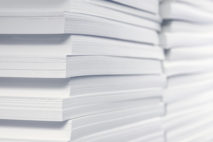This is our new editorial and opinion column. Have a column idea? Contact us at editor@action-intell.com.

Early in my career, my print volumes were less eco-friendly than they are currently. My apologies, Planet Earth. I have amended my ways. Image source: Photos.com.
An Actionable Briefing on print volumes (see “Office Printing: Growing or Declining?”) inspired me to ruminate on my own printing habits, and how many fewer pages I output now than I did earlier in my career. Back in the day, I was a printer/copier vendor’s and a papermaker’s dream. I consumed barrels of ink and toner. I inadvertently slayed forests. In the late 1990s, if you saw a bald patch on an otherwise forest-covered hill, I may have had some personal responsibility in the matter. Now, my print volumes have declined to much more eco-friendly levels. My very rough estimate is that I have gone from an output volume of thousands and thousands of pages per month to tens of pages per month.
In some ways, my experience may be atypical. I started out in book publishing, and now I run a website, so naturally my print volumes have declined. On the other hand, the forces that moved this writer and editor out of the traditional publishing industry have certainly affected others. U.S. News and World Report says the printing and traditional publishing industry lost 22,00 jobs in 2010 and more than a quarter of a million jobs since 2007. Many of us who still work with words in one form or another—and we are the luckier ones—have undergone the transition from print to electronic media.
Glory Days: They Will Pass You By
Because I am not yet quite as old as the hills I have laid bare, in my experience writing has always been done electronically, aside from some really complicated math and one brief experience with a permissions editor who insisted on using a typewriter and who managed a support group for alien abductees in his spare time. But after the manuscript was written and perhaps some electronic developmental or substantive editing if the copy was in rough shape, manuscript was edited as hard copy, using a whole desk drawer full of tools designed specifically for that purpose. Manuscript was then deposited on the desks of the page layout folks, who made changes, then printed out pages to start the cycle anew.
Thousand-page manuscripts were routinely copied multiple times—one for the records, one for the lead author, one for a contributor, one for the layout team, and so forth. Editors sometimes waited in line to do this, meanwhile spreading out heaps of new manuscript to edit on the floor. One company I worked for had surveyed the magazine departments on their copy volumes before deciding on which copiers to install, but somehow neglected to ask the book publishing group about theirs. Thus, the hopelessly low-volume, sluggish copiers broke every two days, generating lots of maintenance revenue as well.
And all this print and copy volume occurred before the print job was sent to press, where the paper consumption and massive use of marking materials really began in earnest. Sometimes millions and millions of pages were printed (high school textbooks); other print jobs demanded only hundreds of thousands of pages (microwave engineering titles). (Note to aspiring editors: do not work on microwave engineering titles.)
Leaner, Meaner, Greener
When I moved to an analyst group at the turn of the millenium, manuscript shrank from book-length to report-and newsletter-length, and the number of pages I was asking a print vendor to output plummeted. After a few years, such publications began to move to PDFs and websites. Eventually, I stopped sending print jobs to press altogether. Sadly, this meant the end of the delightful gift baskets that print service providers send their customers around the holidays.
My in-office print volumes declined as well. Moving publications from hard copy to electronic media often means smaller staffs, and remaining employees must become jacks-of-all-trades. But with fewer people to review documents and fewer passes between writing and electronic “publication,” gradually, almost imperceptibly, almost all editing went electronic, too.
For the past few years, I have worked out of my home office, my sole printing device an inkjet all-in-one, which must fulfill all my office and home printing needs. At one point, it saw decent usage. I replaced a set of cartridges every six to eight weeks. I printed lots of documents for work (primarily brochures, spec sheets, tables, or charts to refer to while writing or editing). But then I discovered the technology that brought my work-related print volume to nearly zilch: dual monitors. Once I could view multiple things at the same time electronically, there was very little need to print at work. My current work-related output is probably about 10 pages per month, mostly receipts. My personal home printing has declined as well, primarily driven by my adoption of a GPS.
Will I ever stop printing entirely? Probably not. Also, it should be noted that because I am in the valuable (to printer makers) mother-with-young-child demographic, I print hundreds of photos each year using an online photo-printing service. Because I am in this demographic, I also consume lots of paper-based consumer products. Remember when The New York Times published an illustration of a paperless home? As a parent of a one-year-old at the time, a couple of things struck me as unrealistic about this home: there is no bathroom and there are clearly no diaper-wearing, food-spilling, nose-dripping children.
Still, my days of generating enormous print volume appear to be over. The fact that so many have followed a similar journey is perhaps the biggest problem facing the printer and supplies industry today and driving printer OEMs to develop various mobile/web printing solutions to keep printing relevant.
What has happened with your print volumes? Have they followed a similar trajectory or have they increased? If you have a print volume-related story to tell, comment below or email us at editor@action-intell.com.
— Christina Bonadio, Executive Editor, Actionable Intelligence






1 Comment
Great article Christina! I’m traversing through this almost paperless age myself and I now print about the same number of pages per month (around 10 or so). When I do use my printer, it’s for USPS mailing labels or my kid’s occasional school paper. I’ve definitely broken my “tree killer” habit as I used to own a personal copier in the past and loved making copies of everything under the sun to hoard in my “this-looks-cool” scrapbook.
I think the older generation and less tech savvy population are more reliant on printed material. It’s likely that by the time our kids become adults or when our grandchildren become of school age, they may well be using tablets in place of textbooks at school. Definitely not a pretty picture for the print and supplies industry!